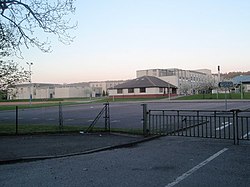|
Inverness Royal Academy
Inverness Royal Academy is a comprehensive secondary school in the city of Inverness in the Highland area of Scotland. A former grammar school with a history dating back to the 13th century, the academy became a comprehensive in the mid-1970s. It has been at its present site in the Culduthel area of the city since 1977. Catchment areaThe school is a six-year comprehensive school serving an extensive area. The associated primary schools are Stratherrick, Aldourie, Cauldeen, Farr, Foyers, Hilton, Holm, Lochardil, Inshes and Bun-sgoil Ghaidhlig Inbhir Nis (Gaelic Primary School Inverness). Children living within the catchment area who attended St. Joseph's and Bishop Eden primaries also transfer there after Primary 7. Parents living outwith the catchment area can request that their children be placed there. At present around one hundred children live outwith the catchment area and attend the academy. HistoryTracing its history back to the school established by Dominican Friars in 1223 through the town Grammar School in 1668 to the founding of the academy in 1792, the school has been located at the following locations around the city.
The school's continuous existence as a developing institution cannot be demonstrated from the surviving evidence, and it is probably safer to interpret that as a succession of educational provisions in and mainly for the burgh, rather than the survival of a single school. There is, however, evidence that concentration on a single site and within a single building was favoured increasingly (as was the pattern elsewhere in Britain and the transatlantic colonies, from which many of the early Academy subscriptions came) in the later eighteenth century, and that the grammar school would be the focus of this, notably during the Rectorship of Hector Fraser, who taught many of the merchants and lawyers involved in the establishment of the Royal Academy, which was from the first an innovative and self-contained project aiming, as its first minute book amply demonstrates, to provide something like a stepping stone to full university status for the burgh, with a curriculum designed in the light of the ideas of the Enlightenment and dominated not by the Classics but by the sciences and mathematics. For the first quarter-century of the academy's existence something like this ideal was sustained, and the appointments of its Rectors showed a bias towards the emerging sciences - for example that of Alexander Nimmo, who became a disciple of Telford, and left in 1811 to work on civil engineering projects in the West of Ireland. He was followed by a mathematician, Matthew Adam. The academy was open to girls from the start, and in its English, writing and drawing classes provided the sort of education for girls that middle-class parents were happy with, although there seems also to have been an enthusiasm for geography. In the mid-nineteenth century one girl was adjudged the best mathematics pupil in the school, but could not be awarded the appropriate medal, which went only to boys. From the opening of the academy in 1792 (when pupils came from all over the Highlands and across the Atlantic, especially the Caribbean - some are shown in the surviving rolls as "coloured") a continuous existence can safely be traced, in which major milestones after 1792 were the adaptation to compulsory schooling after 1872, and the demands of the professions generally, which led to the establishment of the new building on the Crown in 1895. The school's management was by the Inverness School Board after 1910, and later by Inverness County Council and Highland Regional Council. On 28 April 1962 when the school's outdoor club was climbing on Stac Pollaidh, a 15-year-old boy slipped and fell 40 feet to his death. ComprehensiveThere was movement in the 1950s and 1960s (when Gaelic speaking pupils from the Western Isles were still accepted and housed in the Hostel on Culduthel Road) from fee-paying and selectivity to the status of area comprehensive in the mid and late 1970s, again on a new site. On 26 June 1992 the school was visited by the controversial Prince Andrew, Duke of York to celebrate its bi-centenary, with Lachlan Mackintosh of Mackintosh. On 23 November 2009 his brother, Prince Edward, visited the school, having also visited on 11 June 2003. School buildingThe new school building has 4 floors for a variety of subjects. The ground floor has the guidance base, Year head base, 4 technology workshops, P.E classrooms, 2 large games halls, the learning support department as well as the reception in the front, the canteen under the larger atrium and the cafe area under the smaller atrium. The first floor is home to the theatre located above the staircase in the first floor with a drama studio attached. The fitness suite, the dance studio, Geography, History, Modern Studies, Business Studies, Graphic Communication, Engineering Science, Music and Home Economics classrooms. The second Floor has the English, Gaelic, Modern Languages (French, German and Spanish) and Maths classrooms as well as a computer room and 2 unisex toilets. The third floor is home to the Science classrooms (Physics, Biology and Chemistry), the second computer room and Art department with four classrooms. The school was awarded £46 million in order to construct the new building. The construction commenced in summer 2014 and has since been completed. The pupils moved into the new school on 18 August 2016. Notable former pupils
Grammar school
Royal Academy
Previously listed
young enterprisethe Inverness royal Academy has ran the young enterprise for a number of years, listed below are many projects ran by students
See alsoReferences
External links |
||||||||||||||||||||||||||||||||||||||||||
Portal di Ensiklopedia Dunia

